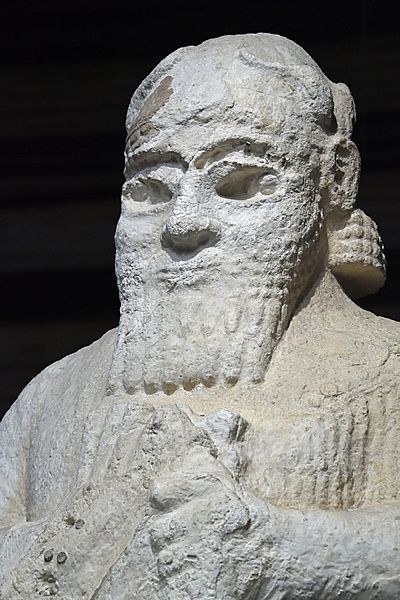Image: Adana Archaeological Museum Late Hittite Tarhunda on chariot 0214

Description: This is a statue of a weather god, Tarhunda, on a wagon pulled by bulls. It was found in the Çineköy village, some 30 km south of Adana. The figure made of limestone wears a headdress with tassels, and under that a band with two horns, identifying him as God. The long straight hair, trimmed beard , and eyes and ears are clearly visible. The upper body is clothed with a cloak , the short sleeves close above the elbow. The clothing below the waist is difficult to see. His hands join before his breast, his right hand holds hands an unidentified object. There are eight small holes that may have served for attachment of another object. The god stands on a chariot drawn by two bulls. These parts of the image are made of basalt. From the left bull's head a part is broken off at the eyes, the rest is in good condition including the yoke. The right draft animal lacks most of the left hind leg. The animals are depicted in motion, muscles, veins, hooves, a long braided tail and other body parts are clearly visible. The wheels of the carriage , eight spokes , however, are only partially preserved . The stand hole of the statue measures 40 × 40 cm and is 30 cm deep. Before the platform that the statue stands on, walls can be seen with three towers, which may symbolize the Kingdom of Awarik, considered the origin of the statue. There is general consensus that the Hittite weather god Tarhunda is depicted, who is mentioned several times in the Luwian text of the inscription. In the Phoenician part of it, as also identified in a bilingual text from Karatepe, with Baal. The monument is created by neo- Hittite standards, but it shows according to Giovanni Lanfranchi in hair, beard and clothing Assyrian influences.
Between the legs of the bulls as well as on the base plate are inscriptions in hieroglyphic Luwian and Phoenician, which form a bilingual text. The author of the inscription is known from Assyrian writings as king Awarikus (Urikki ) of Qu'e (r. 738-732 BC). As is common in ancient Near Eastern royal inscriptions, it consists of two parts, the first presenting the author, the second describing his deeds.
Author: Dosseman
Usage Terms: Creative Commons Attribution-Share Alike 3.0
License: CC-BY-SA-3.0
License Link: http://creativecommons.org/licenses/by-sa/3.0/
Attribution Required?: Yes
Image usage
The following page links to this image:

